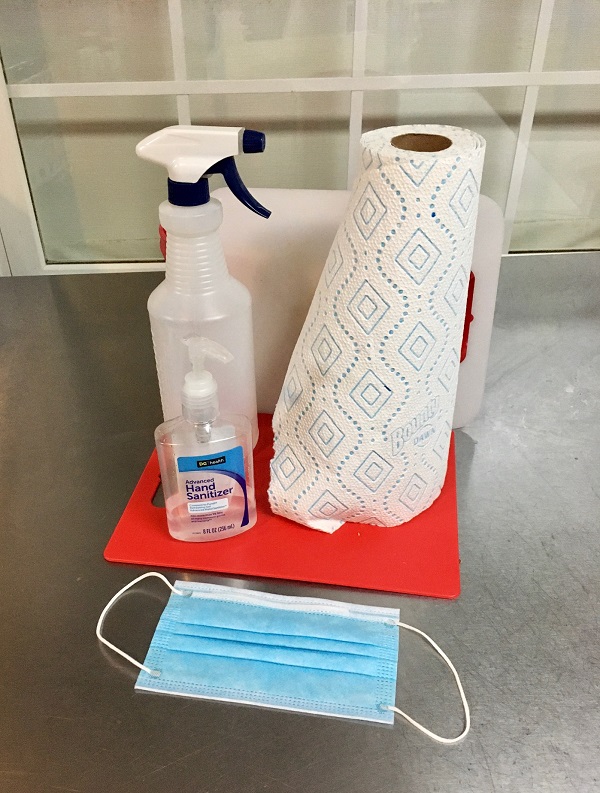Since COVID-19 has entered our lives, many people have had more time to enjoy cooking and having to cook by necessity. This is the first of many articles outlining cooking techniques and equipment used by individuals who are blind or who have low vision, with emphasis on strategies to make life less challenging during the pandemic.
Many of us dread the necessary task of cleaning. We have learned that by establishing routines and techniques, cleaning can be more enjoyable. Since COVID-19, cleaning has become increasingly more important and perhaps more challenging for all, especially for those with vision loss.
Cleaning Versus Disinfecting

In recent months, we have heard the importance of cleaning and disinfecting. What is the difference? According to the CDC:
“Cleaning refers to the removal of germs, dirt, and impurities from surfaces. It does not kill germs, but by removing them, it lowers their numbers and the risk of spreading infection.”
“Disinfecting refers to using chemicals, for example, EPA-registered disinfectants, to kill germs on surfaces. This process does not necessarily clean dirty surfaces or remove germs, but by killing germs on a surface after cleaning, it can lower the risk of spreading infection.”
The following suggestions can be used throughout the cooking process. Some are general; others have been designed for people who are blind or have low vision, but of course, can work for everyone.
Specific Food Prep Recommendations for People with Vision Loss
Step 1. Wash your hands. Follow the CDC guidelines for scrubbing for 20 seconds with soap. Hand washing has always been important throughout the food preparation process, especially for those of us who may use our hands more than most cooks.
Step 2. Wear a surgical cap. A surgical cap is good to use as a hair net. It is cool, lightweight, and does not allow hair to drop into the food. This is an important step for the cook who cannot see well.
Step 3. Prepare a squirt bottle of soapy water. This will enable you to clean up spills as soon as they happen. When using a spray bottle, it is a good practice to spray your cloth only, not the cleaned surface. This gives you more control.
Step 4. Clean your work area. Make sure your work area has been cleaned and sterilized before you start. For people with vision loss, using a grid pattern while cleaning is good. Clean using a vertical design first, then a horizontal pattern. Use the principle of “overwork”, which means overlap what you have already cleaned.
Step 5. Get out all equipment and supplies. Place all of your ingredients on a tray. Knowing you have everything you need before you start is good.
Step 6. Locate all pots and pans and cooking utensils. If you have space on your counter, get out all pots, pans, skillets, cooking utensils and adaptive equipment you need. If you have limited space, get out only what you need immediately, but know where everything is.
Step 7. Use a tray to catch spillage. You should have a tray, cookie sheet, or sink to catch spillage when pouring or measuring.
Step 8. Use an extra bowl for scraps. It would help if you put all scraps of food, including peels and cores, in a bowl so they can be thrown away at once.
Step 9. Clean as You Go
- Wash your hands—again!
- Start with an empty dishwasher. You can pack the dishwasher as you go.
- Pick up and/or clean up any items that fall on the floor immediately. Not only will this action make final cleaning less complicated, it will help prevent accidents such as slipping and falling.
- If you spill or drop a raw egg while cooking, sprinkle salt on it, wait two or three minutes, and wipe it up.
Step 10. Cooking Tips
- “Blind your pot.” If your meal includes boiling, put cooking oil around the rim of your pan. This will prevent the pan from boiling over. You can also place a wooden spoon across the top of the pan with the same result. When I shared this technique with a sighted friend, she affectionately called it “blinding her pot.”
- Use a spatter guard to prevent burns and grease splatters.
- Cook slowly. Be slow and deliberate about measuring, pouring, cutting, chopping, and everything we do in the kitchen. This will result in less cleanup and fewer accidents.
- Use the baking time to perform other tasks. For example, if your dish is in the oven, and you do not have anything that needs your attention, use this time to start cleaning. Remember to wash your hands!
- Start working on a large meal two or three days in advance. This will put less stress on you the day of the event. For example:
- To keep a vegetable tray moist in the refrigerator, place a layer of moist clean paper towels over the vegetables.
- To keep iceberg lettuce fresh, keep lettuce in a clean, dry paper towel and then place in a sealed baggie in the refrigerator.
Cleaning Up After the Meal
- Wash your hands!
- When loading the dishwasher, it is generally not necessary to pre-rinse dishes before placing them in the dishwasher. Put glasses, cups, and wine glasses between the tines, not over the tines. Put plates and casserole dishes on the second shelf, facing the middle of the dishwasher.
- Warning: Often, a cook will prepare a sink full of soapy water to put dirty dishes in as they go. This is a good idea, with one exception. Do not put knives or anything sharp in the water. You may get the point!
Resources
www.blindchef.com
How to Properly Load a Dishwasher